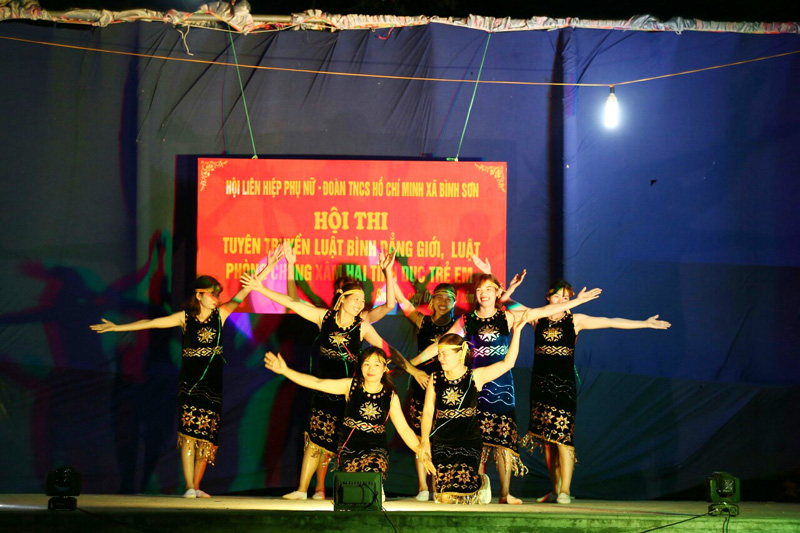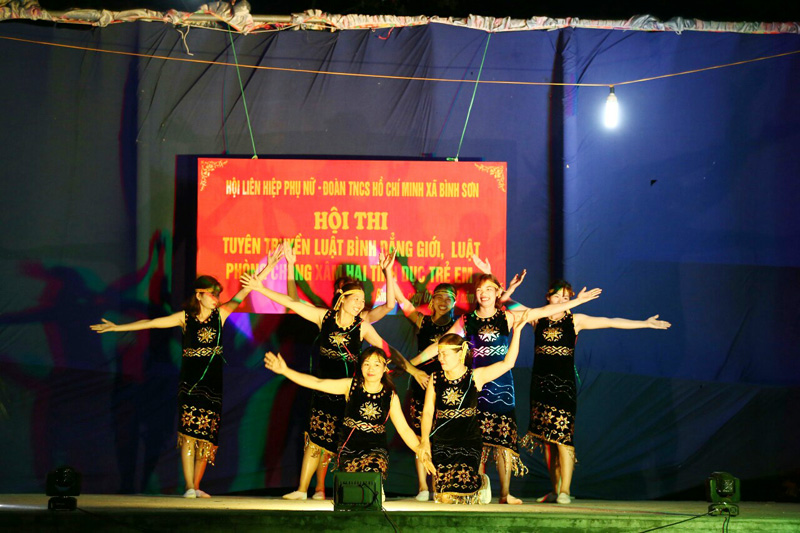
(HBO) - Currently, Binh Son commune in Kim Boi district, Hoa Binh province has 3 outdoor stages and 5 performance teams. The art teams have from 15-20 members.
 A performance by the Binh Son Commune Art Team (Kim Boi District).
A performance by the Binh Son Commune Art Team (Kim Boi District).
Members of the art team gradually rejuvenated, attracting a lot of young people from 15 - 30 years old to participate with a variety of diverse performances such as: singing, dancing, skits, plays, modern dance, singing combined with performances of musical instruments...
The regular music performance teams have contributed to the local cultural and arts movement in both breadth and depth.
Cultural and artistic movements have contributed significantly to building cultural life in residential areas, improving the spiritual life of the people, creating solidarity, cohesion and mutual understanding in the community. Binh Son commune has 495 cultural families, accounting for 75% of the total households in the commune.
Mr. Bui Dinh Luan, Vice Chairman of Binh Son Commune People's Committee said: Every time the commune organizes cultural exchanges, people come to fill the cultural yard to enjoy and cheer. In recent years, activities of the Women's Union and the Elderly Association's activities has been more prosperous than previous years. The local cultural and arts movements have developed, in addition to the interest and investment of the Party Committee and the commune authorities. The enthusiasm and participation in people's activities are now included. Now, the mass music movement has become an indispensable spiritual part in the lives of people in Binh Son commune.
With an increasingly vibrant and widespread emulation movement aimed at building cultured residential areas and cultured families, Yen Thuy District has been making steady progress toward improving both the material and spiritual well-being of its people, while fostering a civilized, prosperous, beautiful, and progressive community.
Once lacking recreational spaces and community facilities, Residential Group 2 in Quynh Lam Ward (Hoa Binh City) has recently received attention for the construction of a new, spacious, and fully equipped cultural house. The project followed the model of state support combined with public contributions in both labor and funding.
The "All people unite to build cultural life" movement, which has been effectively integrated with Kim Boi district’s socio-economic development goals, is fostering a lively spirit of emulation across local residential areas, hamlets, villages, public agencies, and enterprises. In addition, through the initiative, traditional cultural values are being preserved and promoted, while community solidarity and mutual support in poverty reduction and economic development are being strengthened.
A working delegation of the Hoa Binh provincial People’s Committee led by its Permanent Vice Chairman Nguyen Van Toan on June 11 inspected the progress of a project to build the Mo Muong Cultural Heritage Conservation Space linked to tourism services in Hop Phong commune, Cao Phong district.
Born and growing in the heroic land of Muong Dong, Dinh Thi Kieu Dung, a resident in Bo town of Kim Boi district, in her childhood was nurtured by the sweet lullabies of her grandmother and mother. These melodies deeply imprinted on her soul, becoming an inseparable part of her love for her ethnic group's culture. For over 20 years, this love for her hometown has driven Dung to research, collect, and pass down the cultural values of the Muong people to future generations.
In the final days of May, the Ethnic Art Troupe of Hoa Binh Province organized performances to serve the people in remote, mountainous, and particularly disadvantaged areas within the province. These were not just ordinary artistic shows, but they were the meaningful journeys aimed at spreading cultural values, enhancing the spiritual life of the people and contributing to the preservation of ethnic minority cultural identities.



 A performance by the Binh Son Commune Art Team (Kim Boi District).
A performance by the Binh Son Commune Art Team (Kim Boi District).